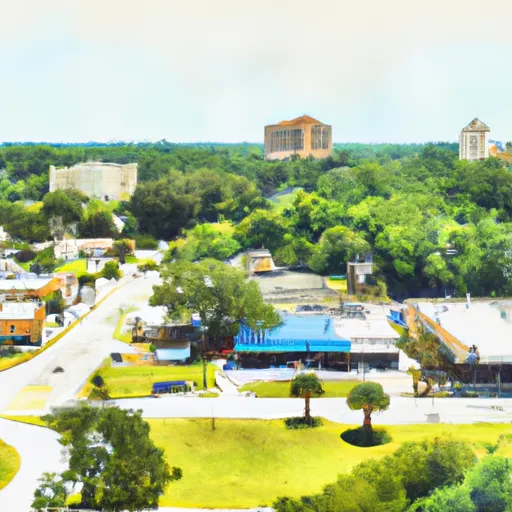-
 Snoflo Premium
Snoflo Premium
Get unlimited access to all our content
With no Ad interruptions! - Start Your Free Trial Login with existing account
Suwannee
Eden Index
Climate
7.0
•
Recreation
4.7
•
Community
•
Safeguard
4.5/10

Suwannee is a small town located in Dixie County, Florida. It is situated along the banks of the Suwannee River, which is a major hydrological feature in the region. The climate in Suwannee is characterized as humid subtropical, with hot and humid summers and mild winters. The area receives abundant rainfall throughout the year, making it ideal for various outdoor activities.
The Suwannee River is a popular destination for outdoor enthusiasts, offering opportunities for boating, fishing, kayaking, and canoeing. It is home to a diverse range of aquatic life, including bass, catfish, and turtles, making it a haven for anglers. Additionally, the surrounding forests and wetlands provide excellent opportunities for bird-watching and wildlife observation.
The natural beauty of Suwannee extends beyond the river, with nearby natural springs and state parks. Manatee Springs State Park, located just a short drive away, offers swimming, snorkeling, and picnic spots. Fanning Springs State Park, another nearby attraction, provides opportunities for swimming, hiking, and camping.
Overall, Suwannee, Florida, with its favorable climate, abundant hydrological features, and various outdoor recreation opportunities, is a fantastic destination for those seeking to immerse themselves in nature and enjoy a multitude of outdoor activities.
What is the Eden Index?
The Snoflo Eden Index serves as a comprehensive rating system for regions, evaluating their desirability through a holistic assessment of climate health, outdoor recreation opportunities, and natural disaster risk, acknowledging the profound impact of these factors on livability and well-being.
Climate Health Indicator (CHI): 7.0
Suwannee receives approximately
1467mm of rain per year,
with humidity levels near 89%
and air temperatures averaging around
21°C.
Suwannee has a plant hardyness factor of
9, meaning
plants and agriculture in this region tend to thrive here all year round.
By considering the ideal temperature range, reliable water supplies, clean air, and stable seasonal rain or snowpacks, the Climate Health Indicator (CHI) underscores the significance of a healthy climate as the foundation for quality living.
A healthy climate is paramount for ensuring a high quality of life and livability in a region, fostering both physical well-being and environmental harmony. This can be characterized by ideal temperatures, reliable access to water supplies, clean air, and consistent seasonal rain or snowpacks.
Weather Forecast
Streamflow Conditions
Aucilla-Waccasassa
Area Rivers
Aucilla-Waccasassa
Snowpack Depths
Aucilla-Waccasassa
Reservoir Storage Capacity
Aucilla-Waccasassa
Groundwater Levels
Recreational Opportunity Index (ROI): 4.7
The Recreational Opportunity Index (ROI) recognizes the value of outdoor recreational options, such as parks, hiking trails, camping sites, and fishing spots, while acknowledging that climate plays a pivotal role in ensuring the comfort and consistency of these experiences.
Access to outdoor recreational opportunities, encompassing activities such as parks, hiking, camping, and fishing, is crucial for overall well-being, and the climate plays a pivotal role in enabling and enhancing these experiences, ensuring that individuals can engage in nature-based activities comfortably and consistently.
Camping Areas
| Campground | Campsites | Reservations | Toilets | Showers | Elevation |
|---|---|---|---|---|---|
| Otter Springs County Park | 100 | 19 ft | |||
| Shell Mound County Park | None | 7 ft | |||
| Suwannee River State Park | None | 74 ft | |||
| Hart Springs | None | 13 ft | |||
| Manatee Springs State Park | None | 25 ft | |||
| Hinton Landing County Park | None | 19 ft | |||
| Shired Creek County Park | None | 11 ft | |||
| Gibson | None | 65 ft | |||
| Horseshoe Beach County Park | None | 9 ft | |||
| Gornto Springs County Park | 24 | 20 ft |
Catastrophe Safeguard Index (CSI):
The Catastrophe Safeguard Index (CSI) recognizes that natural disaster risk, encompassing floods, fires, hurricanes, and tornadoes, can drastically affect safety and the overall appeal of an area.
The level of natural disaster risk in a region significantly affects safety and the overall livability, with climate change amplifying these risks by potentially increasing the frequency and intensity of events like floods, fires, hurricanes, and tornadoes, thereby posing substantial challenges to community resilience and well-being.
Community Resilience Indicator (CRI):
The Community Resilience Indicator (CRI) recognizes that education, healthcare, and socioeconomics are crucial to the well-being of a region. The CRI acknowledges the profound impact of these elements on residents' overall quality of life. By evaluating educational resources, healthcare accessibility, and economic inclusivity, the index captures the essential aspects that contribute to a thriving community, fostering resident satisfaction, equity, and social cohesion.

